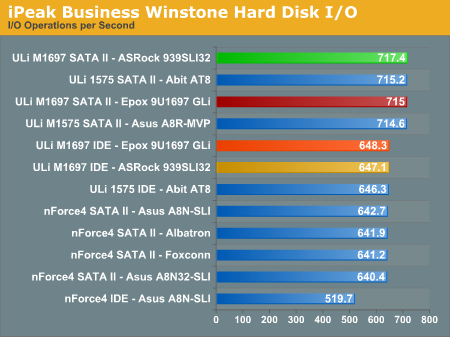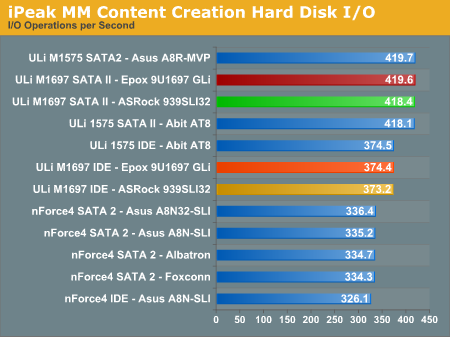EPoX EP-9U1697-GLi: ULi M1697 Goes Mainstream
by Gary Key on March 15, 2006 12:05 AM EST- Posted in
- Motherboards
Disk Controller Performance
With the variety of disk drive benchmarks available, we needed a means of comparing the true performance of the wide selection of controllers. The logical choice was Anand's storage benchmark first described in Q2 2004 Desktop Hard Drive Comparison: WD Raptor vs. the World. The iPeak test was designed to measure "pure" hard disk performance, and in this case, we kept the hard drive as consistent as possible while varying the hard drive controller. The idea is to measure the performance of a hard drive controller with a consistent hard drive.
We played back Anand's raw files that recorded I/O operations when running a real world benchmark - the entire Winstone 2004 suite. Intel's iPEAK utility was then used to play back the trace file of all IO operations that took place during a single run of Business Winstone 2004 and MCC Winstone 2004. To try to isolate performance differences to the controllers that we were testing, we used the Maxtor MaXLine III 7L300S0 300GB 7200 RPM SATA drive in all tests . The drive was formatted before each test run and a composite average of 5 tests on each controller interface was tabulated in order to ensure consistency in the benchmark.
iPeak gives a mean service time in milliseconds; in other words, the average time that each drive took to fulfill each IO operation. In order to make the data more understandable, we report the scores as an average number of IO operations per second so that higher scores translate into better performance. This number is meaningless as far as hard disk performance is concerned, as it is just the number of IO operations completed in a second. However, the scores are useful for comparing "pure" performance of the storage controllers in this case.
With the variety of disk drive benchmarks available, we needed a means of comparing the true performance of the wide selection of controllers. The logical choice was Anand's storage benchmark first described in Q2 2004 Desktop Hard Drive Comparison: WD Raptor vs. the World. The iPeak test was designed to measure "pure" hard disk performance, and in this case, we kept the hard drive as consistent as possible while varying the hard drive controller. The idea is to measure the performance of a hard drive controller with a consistent hard drive.
We played back Anand's raw files that recorded I/O operations when running a real world benchmark - the entire Winstone 2004 suite. Intel's iPEAK utility was then used to play back the trace file of all IO operations that took place during a single run of Business Winstone 2004 and MCC Winstone 2004. To try to isolate performance differences to the controllers that we were testing, we used the Maxtor MaXLine III 7L300S0 300GB 7200 RPM SATA drive in all tests . The drive was formatted before each test run and a composite average of 5 tests on each controller interface was tabulated in order to ensure consistency in the benchmark.
iPeak gives a mean service time in milliseconds; in other words, the average time that each drive took to fulfill each IO operation. In order to make the data more understandable, we report the scores as an average number of IO operations per second so that higher scores translate into better performance. This number is meaningless as far as hard disk performance is concerned, as it is just the number of IO operations completed in a second. However, the scores are useful for comparing "pure" performance of the storage controllers in this case.












35 Comments
View All Comments
Palek - Wednesday, March 15, 2006 - link
Gary,There is a spelling error in the last sentence of the 1st page:
"Let's find out how Epox's offering fairs against the competition."
The correct spelling is "fares" not "fairs".
Gary Key - Wednesday, March 15, 2006 - link
I had corrected it on the final draft and somehow it still made it in. My fault for not catching it once the article went live last night. It is corrected now as are the ascending chart figures.Googer - Wednesday, March 15, 2006 - link
Is epox part of Shuttle?http://local.google.com/local?q=Epox%20EP-9U1697-G...">http://local.google.com/local?q=Epox%20...utf-8&am...
Googer - Wednesday, March 15, 2006 - link
The ULi M1695 is all about upgradeability and the ASrock implementation uses a 20pin PSU where as the Epox implementation needs a 24pin connection. Based on the benchmarks it also looks like you will need to purchase a PCI-e x1 gigabit controller.Speaking from experience, my biggest gripe on the ASrock M1695 is the BIOS is very quirky and can be very very slow to POST.
Epox is the king if you are an overclocker and overall performance is very impressive compaired to the ASrock ULi M1695.
Avalon - Wednesday, March 15, 2006 - link
8Mb throughput? Are you sure that's not a mistake?The only comment on Epox's ethernet score was that it was not competitive...700Mb vs 8Mb...I'd say something is wrong, or a typo?
Palek - Wednesday, March 15, 2006 - link
Yeah, I noticed that, too, then I found the missing "9" outside the graph area. The figure is correct, it's just the layout that is messed up.Gary Key - Wednesday, March 15, 2006 - link
The actual number is 98.9Mb/s. Our graph engine has a small issue with variances that wide. It placed the 9 into the description field. I updated the text statement to reflect this issue. Thank you.Peter - Friday, March 17, 2006 - link
While you're updating, you might want to correct the research error that the RTL8201 is a "PCI based solution". It is not, it's just a PHY to the ULi chip's integrated 10/100 MAC.Oh, and when are you finally going to stop attributing memory performance to chipsets on AMD64?
Cygni - Wednesday, March 15, 2006 - link
Might have to pick one of these up...Rock Hydra - Wednesday, March 15, 2006 - link
The Epox EP-9U1697 GLi displayed superb stability with 4 DDR2 modules in Dual-Channel operation at the settings of 2-2-2-7, but it required the command rate to be increased to 2T.